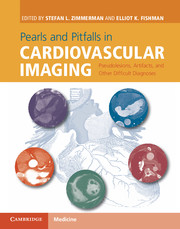 Pearls and Pitfalls in Cardiovascular Imaging
Pearls and Pitfalls in Cardiovascular Imaging from Section 11 - Veins
Published online by Cambridge University Press: 05 June 2015
Imaging description
Venous malformations are characterized by dilated venous spaces with normal arterial components. They appear as soft tissue nodules on non-contrast computed tomography (CT) (Figure 98.1) and demonstrate slow, gradual nodular filling with contrast on delayed venous phase images with a prolonged contrast rise time of about 90 seconds (Figure 98.2). If thrombosed, these show lack of enhancement on contrast-enhanced CT or MRI. Phleboliths are usually present and appear as calcified nodules on CT (Figure 98.1). On MRI, venous malformations are typically low-flow abnormalities characterized by decreased signal intensity on T1-weighted images and high signal on fat suppressed T2-weighted MR images (Figure 98.3). High-signal intensity on T1-weighted images and internal fluid–fluid levels on T2-weighted images are indicative of the presence of hemorrhage or high protein content (Figure 98.3). Delayed enhancement is often appreciated in the slow-flowing veins (Figure 98.4). Furthermore, there is absence of arterial and early venous enhancement or arteriovenous shunting, distinguishing venous malformations from high-flow malformations or arteriovenous fistulas. Phleboliths appear as small low signal intensity foci on all pulse sequences. Due to their nodular appearance, extensive venous malformations in the abdominal cavity can have an appearance similar to carcinomatosis (compare Figure 98.1 to Figure 98.5), particularly on non-contrast examinations.
Importance
Although present at birth, patients with venous malformations may become symptomatic in late childhood or early adulthood. Complications of venous malformations depend on the area of involvement and include rectal rectal bleeding, hematuria, epistaxis, deep vein thrombosis, pulmonary embolism, infection, and coagulopathy. Misdiagnosis of venous malformations as carcinomatosis could lead to inappropriate biopsy with potentially disastrous consequences due to high bleeding risk.
Typical clinical scenario
Venous malformations may be seen in isolation or in combination with a variety of syndromes such as Klippel–Trenaunay–Weber, Sturge–Weber, and Proteus syndrome. Severe angiomatosis with extensive venous malformations seen in Klippel–Trenaunay–Weber is characterized by a triad of port-wine stain, venous varicosities and malformations and osseous and soft tissue hypertrophy.
To save this book to your Kindle, first ensure [email protected] is added to your Approved Personal Document E-mail List under your Personal Document Settings on the Manage Your Content and Devices page of your Amazon account. Then enter the ‘name’ part of your Kindle email address below. Find out more about saving to your Kindle.
Note you can select to save to either the @free.kindle.com or @kindle.com variations. ‘@free.kindle.com’ emails are free but can only be saved to your device when it is connected to wi-fi. ‘@kindle.com’ emails can be delivered even when you are not connected to wi-fi, but note that service fees apply.
Find out more about the Kindle Personal Document Service.
To save content items to your account, please confirm that you agree to abide by our usage policies. If this is the first time you use this feature, you will be asked to authorise Cambridge Core to connect with your account. Find out more about saving content to Dropbox.
To save content items to your account, please confirm that you agree to abide by our usage policies. If this is the first time you use this feature, you will be asked to authorise Cambridge Core to connect with your account. Find out more about saving content to Google Drive.